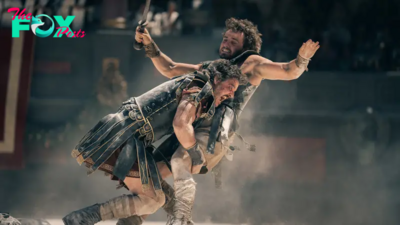Entertainment
The Story Behind The Outrun
It’s not often that an addiction drama feels like a nature documentary, but from its opening moments, The Outrun seems to want to be mistaken for one.
Though the film eventually finds its way to Saoirse Ronan’s captivating lead performance as a recovering alcoholic, The Outrun begins underwater, observing a lonesome seal in the North Sea. There, along the Orkney Islands, primordial land masses off the blustery and chilly Scottish coast, it’s common folklore that these “selkies” are actually drowned human souls who take the form of the seal for safety in the freezing water before shedding their skin and reverting to two legs on shore. In this harsh and isolated area of the world, that kind of magical transformation doesn’t seem too far-fetched.
As evidenced in this serene opening sequence, Nora Fingscheidt’s searching and soulful adaptation of Amy Liptrot’s award-winning memoir makes good on its source material’s harmonious blend of sealife, mythology, and metaphor—and the extremes of a disease that can often feel like waves crashing into craggy rocks. Taking few liberties with Liptrot's story, it follows Rona, a biology student who has spent seven years living in London, but whose promising future at work and with her boyfriend is upended by her alcohol abuse, which spirals into frequently harmful nights out. After completing three months of rehab, the 29-year-old decides to return home to Orkney, where her separated parents still live, taking a nature conservancy job as she struggles to stay sober.
Maybe, she thinks, it will lead to her own transformation, and help her to begin a new, clean chapter of life.
Leaning on Liptrot’s personal experiences and writing, Fingscheidt explores both spectrums of the author’s drunken and sober life in the film. Like the violent winds that make up the unpredictable life on Orkney, the movie whips back and forth along its timeline, bringing Rona’s messy past and isolated present into direct conversation. The jagged structure lends some drama and mystery to certain aspects of her journey, but it mostly captures the feeling of relapsing—and the bipolar nature of her recovery.
“That’s sort of how the healing process works,” Liptrot tells TIME in a recent interview, speaking from inside a caravan on her father’s Orkney farm. “I finally got sober for 13-and-a-half years yesterday. It's really hard to quit.”

When Liptrot began to write The Outrun in 2011, she thought it would help her continue to process life as a recovering alcoholic. Throughout her time in rehab, she’d posted blogs that chronicled some of her damaging experiences. And once she returned home to Orkney, she started a nature column about island life and farming in the natural world. “These two bodies of work came together in this book,” she says. “More than cathartic, it was sort of artistically satisfying. I was finally doing the type and quality of writing that I'd always hoped that I would. I was writing about getting sober, but the writing itself was helping me to stay sober.”
Not long after her memoir was published in 2016, Liptrot was approached by numerous filMMAkers about securing a movie option for her recovery tale. “It was something I thought quite seriously about: Is this a process that I want to enter into?” Liptrot says. “I remember going for a long walk and considering it all.” She ultimately perked up when eventual producer Sarah Brocklehurst sent her a love letter about the book, offering some ideas about how to adapt it and sharing some movie references, including Andrea Anrold’s Wuthering Heights and the Scottish film Movern Callar, to describe her vision. “The other thing that she was quite clear on was that she would like me to be involved in the process,” Liptrot says.
Saoirse Ronan signed on to the project a few years later (her husband, the actor Jack Lowden, introduced the book to her and has a producing credit), but it wasn’t until Fingscheidt joined the project that Liptrot began aiding the creative process. The director built out a script with a structure similar to the book, and enlisted Liptrot, credited as a screenwriter, to provide what they called the “nerd layer,” the movie’s journalistic, narrated observations about Orkney’s nature and long-held legends. The pair swapped ideas between Los Angeles and Yorkshire, changing the order of things and honing in on specific life events.
“I felt that this nerd layer really lifted what could have been a more straightforward adaptation,” Liptrot says. “We would have these long conversations and then she would come back with something written that would pick out unexpected details of something that I mentioned, combined with details from the book in new and inventive ways.”
The memoir, which is organized along various themes, is broadly chronological, but pivots around Liptrot’s memories on a whim. “Sometimes I say it’s about beauty, sensation and the feeling of cold water on hot skin,” she wrote in The Guardian upon its release. “Sometimes I say it’s about birds and addiction. Sometimes I say it’s about a period in my life when I’d returned to Orkney after I got out of rehab in London.” The coNFLation of events iNFLuenced her and Fingscheidt’s decision to build a nonlinear screenplay and lean into its literary feel.
To aid the writing process—and allow for some fictional leeway—they decided to name the movie’s protagonist Rona so they could avoid using Liptrot’s name. But things still got blurry—like when the production moved to the real caravan where her father lived, or when Ronan set up shop in the same rose house on Papa Westray, a remote island off the Orkneys, where Liptrot began writing her book. Outside of Rona’s background as a biology student and an added relapse on Orkney, “almost every scene in there is something real that happened to me,” Liptrot says.

Ahead of filming, Liptrot and Ronan had a few Zoom conversations in which the Oscar-winning actress, playing a living person for the first time in her career, began asking questions about various aspects of her time in a 12-step program and on the islands. “I do feel that she didn't get her main inspiration from me as a person,” Liptrot says. “She's not doing an impression of me. I think what she was channeling was my writing—that kind of slightly elevated voice that I have. My writing gets to be manifested rather than my slightly nervous, normal person.”
Though Liptrot concedes, there was at least one glaring similarity: “She’s got that little frown that you do,” her friend observed.
Liptrot didn’t spend too much time on set, but she had full access to Fingscheidt’s scenes each day, which she watched come together in the editing room. The experience was a strange one, like going down a looking glass. “There was this moment when I clicked the link and suddenly, my real memory, and how I wrote it in the book, was overtaken by this new physical manifestation of those scenes,” she says. Watching her character get drunk was much harder, but she praises Fingscheidt for not turning the camera away too quickly from them. “Nora made some quite strong decisions to let some of these scenes play out at quite some length, and quite some awkwardness,” she says.
Since the movie premiered at the Sundance Film Festival in January, Liptrot has been overwhelmed by the movie’s existence and the early buzz around Ronan’s award-worthy performance. The night before we spoke, she had just shown the movie to Orkney residents at a red-carPet style event where the entire island dressed up.
“I feel just really proud that my story has added something to the tapestry of Orkney and the culture of the islands,” she says.
But unlike her recovery journey, she adds, “there's no guidebook for this experience for me.”
-

 Entertainment4h ago
Entertainment4h agoAmerica On CoffeeWe’re simply inviting you to take a timeout into the rhythmic ambiance of our breakfast, brunch and/or espresso alternatives. We’re pleased everytime you cease by.SELF CONTROL
-

 Entertainment6h ago
Entertainment6h agoOrange County Choppers Is Ready For Its Big Comeback
-

 Entertainment12h ago
Entertainment12h agoSki Area Officially Opens the Ski Season For New York
-

 Entertainment16h ago
Entertainment16h agoGladiator II Belongs to Denzel
-

 Entertainment16h ago
Entertainment16h agoJJ Velazquez on Finding Freedom, From Sing Sing to Sing Sing
-

 Entertainment20h ago
Entertainment20h ago13 Most Romantic Movies Based on Novels
-

 Entertainment21h ago
Entertainment21h agoThe Monkey Is the Secret Hero of Gladiator II
-

 Entertainment21h ago
Entertainment21h agoHow Wicked Connects to The Wizard of Oz



















